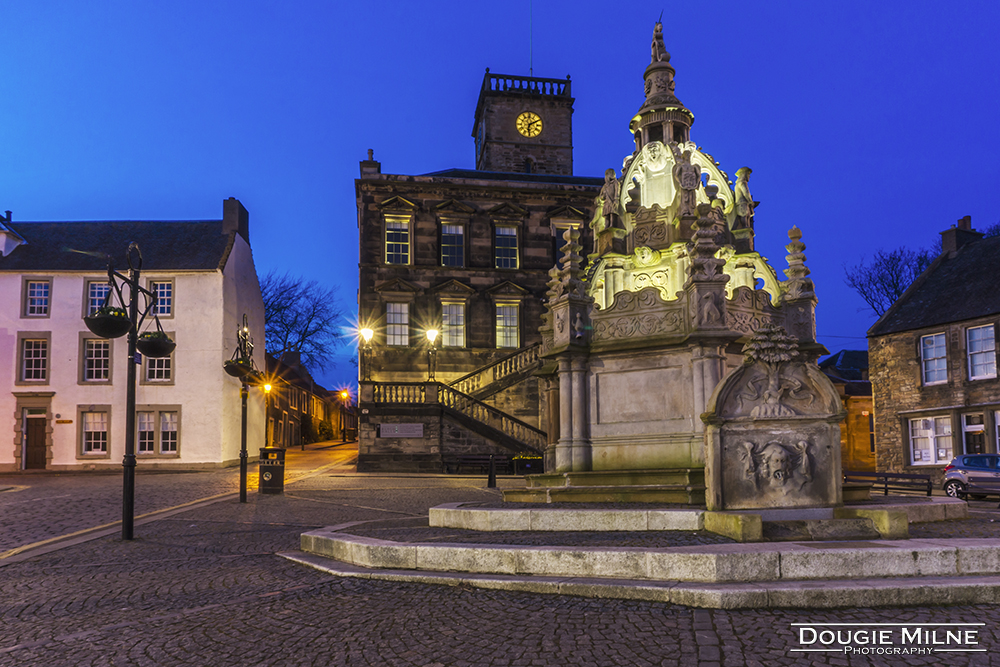
Click on picture for buying options
TweetI wrote the following article for Scotland Magazine (Issue 108, January / February 2020)
Linlithgow Cross
There is an old Scottish rhyme which goes:
Glasgow for bellsLithgow for wellsFalkirk for beans and peasPeebles for glasses and lees
The second line refers to the seven wells that once stood along Linlithgow High Street. The most prominent of these was Linlithgow Cross, a veritable cornucopia of intricate, elaborate sculptures and ostentatious grandeur.
The current well at Linlithgow Cross is not the first. There has been a well on this site since around 1535, when James V erected a dipping well in front of the Burgh Halls, in close proximity to his Royal Palace. The well stood for nearly 100 years but became dilapidated over time. In the Town Council minutes of 1628, it was described as 'ane deid monument and necessary to be helpit for decorment of the croce'. John Richie of Edinburgh was employed to rebuild it.
With its carvings of roses and thistles, depictions of the oak tree and the "Black Bitch" from Linlithgow's Burgh Coat of Arms, and a prominent figure wearing a sash emblazoned "God Save the King", Richie's Cross celebrated the 25 year old Union of the Crowns, and the importance of Linlithgow's status as a Royal Burgh. And it was more than just a well, it was also a fountain.
But in 1650, Oliver Cromwell came to the town. The previous year, Charles I had been beheaded at the end of the English Civil War, and a proclamation had been made at Linlithgow Cross declaring his son Charles II of Scotland. Cromwell invaded Scotland and defeated the Scots at the Battle of Dunbar on 3 September 1650. He chose to spend the winter at Linlithgow Palace. His soldiers tore down the buildings in the Kirkgate to build a defensive wall around the Palace, and caused extensive damage to the well - the blatant Royalism celebrated in the fountain must have seemed anathema to Cromwell's hard-line Republican sentiments.
The fountain remained in ruins until Cromwell's death in 1658, when it was repaired by stonemason James Thomsone. However, the repair work was obvious, so the Town Council ordered that it should be painted "haillie colored with the oil of lintseid and wheit leid". As the minutes do not mention colours or pigmentation, it is likely that the coating of linseed oil and white lead was a bright white.
Over the next 150 years, Linlithgow Cross again became dilapidated. In 1806, the Town Council recruited the architect James Haldane to design a replacement, stipulating that the new well should be an exact replica of the existing one. Robert Gray, a one-armed stonemason from Edinburgh who worked with a mallet strapped to his stump, was contracted to rebuild it yet again, based on Haldane's design. He assembled a team of four stone cutters and undertook to complete the work in twelve months beginning 1 July 1806.
The foundation stone was laid by Provost Alexander Learmonth on 4th June 1807. Gray was paid 300 guineas, or £315 (£20,250 today) for his efforts.
Restoration
Robert Gray's Cross Well has survived for over 2 centuries, but for many years suffered from neglect and damage. In Autumn of 2011, West Lothian Council assessed the condition of the stone (eg scaling, delamination, cracks and pits in the stone, salt efflorescence, ferrous fixings, previous repairs, loss of detail and construction joints), damages through environmental pollution (for example, biological growth, bird guano and insect deposits) and graffiti, and discussed the options to restore the well. A £65,000 contract was announced to restore the stonework, replace the floodlighting and restore the water supply, returning the water works to the well.
The necessary conservation work was carried out over an eight-week period between September and October 2016.
As part of the restoration work, a time capsule was installed underneath the well on 17 November 2016. As well as material supplied by local groups and school, the capsule also contains copies of the original contract from 1806, as well as correspondence between Robert Gray and the Town Council.
The restoration work that has been carried out should ensure that Gray's well and fountain survive well into the 22nd century and beyond, maintaining a five-hundred-year-old link to Linlithgow's historic roots.
This picture was taken on 23 February 2018.